I principianti ci chiedono spesso di spostare i loro siti web su SSL o HTTPS. I termini possono sembrare troppo tecnici, ma in realtà è molto facile da fare.
L’HTTPS nell’URL di un sito web significa che questo utilizza un protocollo di trasferimento dati sicuro grazie all’installazione di un certificato SSL. Questo è importante perché la maggior parte dei browser moderni mostra avvisi per i siti web che non utilizzano HTTPS.
Fortunatamente, la maggior parte delle società di hosting affidabili e WordPress rendono molto facile proteggere il vostro sito web.
In questo articolo vi mostreremo come spostare il vostro WordPress da HTTP a HTTPS aggiungendo un certificato SSL. Non preoccupatevi se non sapete cosa sia SSL o HTTPS. Vi spiegheremo anche questo.
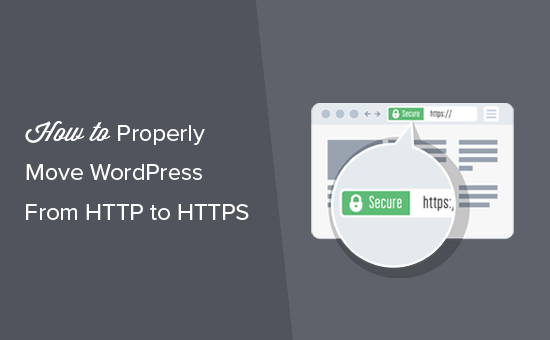
Ecco una rapida panoramica degli argomenti che tratteremo in questo articolo:
- What Is HTTPS?
- Why Do You Need HTTPS and SSL?
- Requirements for Using HTTPS/SSL on a WordPress Site
- Setting Up WordPress to Use SSL and HTTPS
- Method 1: Setup SSL/HTTPS in WordPress Using a Plugin
- Method 2: Set Up SSL/HTTPS in WordPress Manually
- Submit Your HTTPS Site to Google Search Console
- Bonus Resources
- Video Tutorial
Che cos’è l’HTTPS?
HTTPS, o Secure HTTP, è un metodo di crittografia che protegge la connessione tra il browser dell’utente e il vostro server. Questa maggiore sicurezza rende molto più difficile per gli hacker intercettare i dati trasferiti.
Ogni giorno le persone condividono i propri dati personali con i siti web, sia che stiano effettuando acquisti sia che stiano semplicemente effettuando il login. Abbiamo visto in prima persona quanto sia cruciale proteggere questo tipo di scambio di dati.
Per garantire la sicurezza dei dati, è necessario stabilire una connessione sicura.
È qui che entrano in gioco SSL e HTTPS.
Ogni sito web riceve un certificato SSL unico per l’identificazione. Se un server tenta di utilizzare HTTPS senza un certificato valido o se il certificato non corrisponde, la maggior parte dei browser moderni avvisa gli utenti e consiglia loro di non procedere.
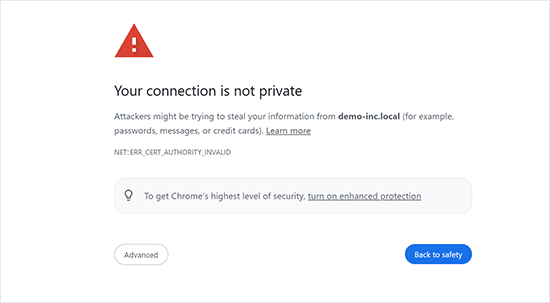
Ora, potreste chiedervi perché sia necessario spostare il vostro sito WordPress da HTTP a HTTPS, soprattutto se si tratta di un semplice blog o di un sito web di una piccola azienda che non effettua pagamenti.
Perché avete bisogno di HTTPS e SSL?
Nel 2018 Google ha annunciato un’iniziativa per aumentare la sicurezza del web, esortando i proprietari di siti a passare da HTTP a HTTPS. Per supportare questa mossa, il browser Chrome ha iniziato a contrassegnare tutti i siti web senza un certificato SSL come “Non sicuro”.
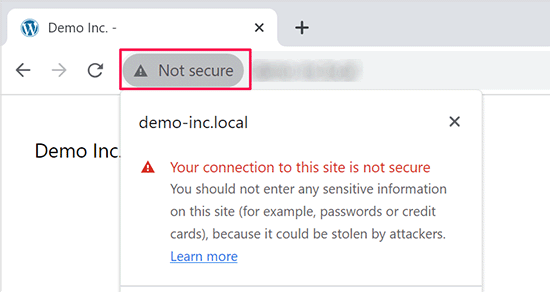
Google ha anche detto che i siti con SSL avrebbero ricevuto vantaggi SEO e avrebbero potuto ottenere un posizionamento di ricerca più alto rispetto ai siti non sicuri. Questo annuncio ha spinto molti proprietari di siti a passare all’HTTPS.
Una volta diffuso l’avviso “Non sicuro”, Chrome ha iniziato a segnalare i siti HTTP. Ad esempio, visitando un sito HTTP in modalità incognito o compilando un modulo di contatto su un sito HTTP si attiva l’avviso, contrassegnandolo come non sicuro.
Quando i visitatori vedono questo avviso, possono lasciare un’impressione negativa del vostro sito o della vostra azienda.
Per questo motivo tutti i siti web devono passare all’HTTPS e installare l’SSL il prima possibile.
Inoltre, l’SSL è indispensabile se si desidera accettare pagamenti online sul proprio sito di e-commerce.
I fornitori di pagamenti come Stripe, PayPal Pro e Authorize.net richiedono una connessione di pagamento sicura.
Ci assicuriamo che i nostri siti utilizzino l’SSL, compresi WPBeginner, OptinMonster, WPForms e MonsterInsights.
Requisiti per l’utilizzo di HTTPS/SSL su un sito WordPress
I requisiti per l’utilizzo di SSL in WordPress non sono molto elevati. Tutto quello che dovete fare è acquistare un certificato SSL, che potreste già avere gratuitamente.
Le migliori società di hosting WordPress offrono certificati SSL gratuiti a tutti i loro utenti:
Per maggiori dettagli, consultate la nostra guida su come ottenere un certificato SSL gratuito per il vostro sito WordPress.
Se il vostro ospitato non offre un certificato SSL gratuito, dovrete acquistarne uno.
Raccomandiamo Domain.com perché offre la migliore offerta di certificati SSL normali e wildcard.
Acquistando un certificato SSL, si ottiene anche un sigillo TrustLogo per il proprio sito web. Ogni certificato SSL viene fornito con una garanzia di sicurezza minima di 10.000 dollari. I prezzi partono da 33 dollari all’anno e i certificati SSL vengono rinnovati automaticamente.
Una volta acquistato un certificato SSL, dovrete chiedere al vostro provider di hosting di installarlo per voi.
Avete bisogno di aiuto per impostare l’SSL e passare all’HTTPS?
Se non avete tempo per impostare l’SSL, il nostro servizio diassistenza Premium WordPress è qui per aiutarvi! Possiamo gestire l’intero processo per voi, assicurandovi che il vostro sito sia sicuro e pronto per i visitatori.
- Tassa una tantum
- Tempi di consegna rapidi
- Disponibile su richiesta 24 ore su 24, 7 giorni su 7
Potete stare tranquilli sapendo che il vostro sito è in mani esperte. Contattateci oggi stesso per un’installazione SSL e una migrazione HTTPS senza problemi!
Impostazione di WordPress per l’utilizzo di SSL e HTTPS
Dopo aver abilitato un certificato SSL per il vostro dominio, dovrete impostare WordPress per utilizzare i protocolli SSL e HTTP sul vostro sito web.
Vi mostreremo due metodi per farlo e potrete scegliere quello più adatto alle vostre esigenze.
Metodo 1: Impostare SSL/HTTPS in WordPress utilizzando un plugin
Questo metodo è più semplice ed è consigliato ai principianti.
Per prima cosa, è necessario installare e attivare il plugin Really Simple SSL. Per maggiori dettagli, consultate la nostra guida passo passo su come installare un plugin di WordPress.
Dopo l’attivazione, è necessario visitare la pagina Impostazioni ” SSL. Il plugin rileverà automaticamente il vostro certificato SSL e imposterà il vostro sito WordPress per l’utilizzo di HTTPS.
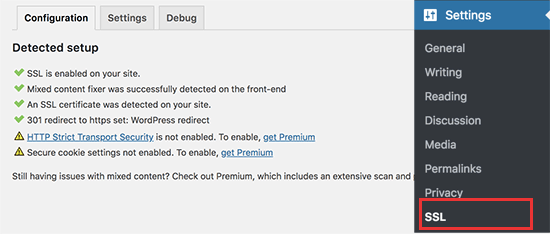
Il plugin si occuperà di tutto, compresi gli errori di contenuto misto. Ecco cosa fa il plugin dietro le quinte:
- Controllare il certificato SSL
- Impostate WordPress per utilizzare https negli URL
- Impostazione di reindirizzamenti da HTTP a HTTPS
- Cercate nei vostri contenuti gli URL che vengono ancora caricati da fonti HTTP non sicure e cercate di risolverli.
Nota: il plugin tenta di risolvere gli errori di contenuto misto utilizzando una tecnica di buffering dell’output. Questo può avere un impatto negativo sulle prestazioni, perché sostituisce il contenuto del sito mentre la pagina viene caricata. Questo impatto è visibile solo al primo caricamento della pagina e dovrebbe essere minimo se si utilizza un plugin per la cache.
Anche se il plugin dice che è possibile mantenere SSL e disattivare il plugin in modo sicuro, non è vero al 100%. Dovrete lasciare il plugin sempre attivo perché la disattivazione del plugin riporterà gli errori di contenuto misto. Per maggiori dettagli, consultate la nostra recensione di Really Simple SSL.
Metodo 2: Impostazione manuale di SSL/HTTPS in WordPress
Questo metodo richiede la risoluzione manuale dei problemi e la modifica dei file di WordPress. Tuttavia, è una soluzione permanente e più ottimizzata dal punto di vista delle prestazioni e la stiamo utilizzando su WPBeginner.
Se trovate questo metodo difficile, dovreste assumere uno sviluppatore WordPress o utilizzare il primo metodo.
Potrebbe essere necessario modificare il tema di WordPress e i file di codice come parte di questo metodo. Se non l’avete mai fatto prima, consultate la nostra guida su come copiare e incollare frammenti di codice in WordPress.
Per prima cosa, è necessario visitare la pagina Impostazioni ” Generale. Da qui, è necessario aggiornare i campi dell’indirizzo URL di WordPress e del sito sostituendo http con https.
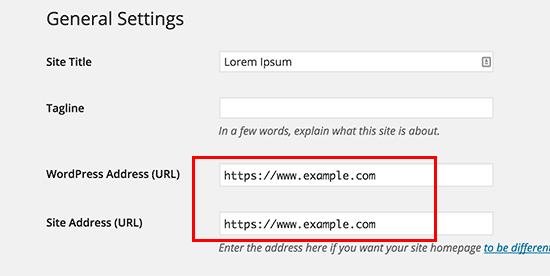
Non dimenticate di fare clic sul pulsante “Salva modifiche” per memorizzare le impostazioni.
Una volta salvate le impostazioni, WordPress vi farà uscire e vi chiederà di effettuare nuovamente il login.
Successivamente, è necessario impostare il reindirizzamento di WordPress da HTTP a HTTPS aggiungendo il seguente codice al file .htaccess:
1 2 3 4 5 | <IfModule mod_rewrite.c>RewriteEngine OnRewriteCond %{HTTPS} offRewriteRule ^(.*)$ https://%{HTTP_HOST}%{REQUEST_URI} [L,R=301]</IfModule> |
Se si utilizzano server NGINX, è necessario aggiungere il seguente codice per reindirizzare da HTTP a HTTPS nel file di configurazione:
1 2 3 4 5 | server {listen 80;server_name example.com www.example.com;return 301 https://example.com$request_uri;} |
Non dimenticate di sostituire example.com con il vostro nome di dominio.
Seguendo questi passaggi, eviterete l’errore WordPress HTTPS not working perché WordPress ora caricherà l’intero sito web utilizzando HTTPS.
Se si desidera forzare SSL e HTTPS nell’area di amministrazione di WordPress o nelle pagine di login, è necessario configurare SSL nel file wp-config.php.
Aggiungete il seguente codice sopra la riga “That’s all, stop editing!” nel file wp-config.php:
1 | define('FORCE_SSL_ADMIN', true); |
Questa riga consente a WordPress di forzare SSL/ HTTP nell’area di amministrazione di WordPress. Funziona anche sulle reti multisito di WordPress.
Una volta eseguita questa operazione, il sito web è completamente configurato per l’utilizzo di SSL/ HTTPS, ma si verificheranno ancora errori di contenuto misto.
Questi errori sono causati da fonti (immagini, script o fogli di stile) che vengono caricate utilizzando il protocollo HTTP non sicuro negli URL. In questo caso, non è possibile vedere l’icona del lucchetto sicuro nella barra degli indirizzi del sito web.
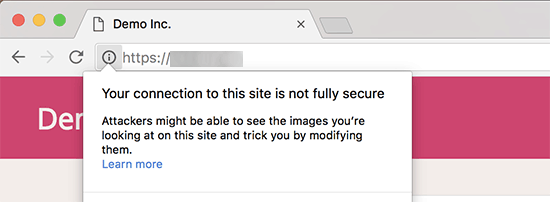
Molti browser moderni bloccano automaticamente gli script e le risorse non sicure.
Potreste vedere un’icona a forma di lucchetto, ma con una notificazione su chi siamo, nella barra degli indirizzi del browser.
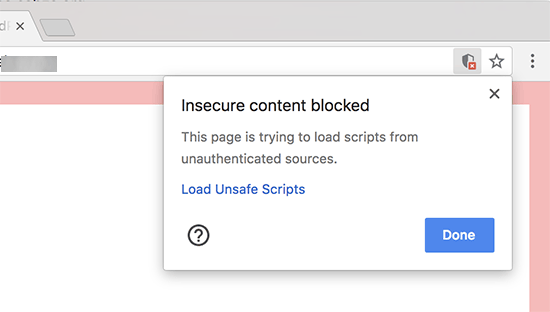
È possibile scoprire quali contenuti sono serviti attraverso un protocollo non sicuro utilizzando lo strumento Inspect.
L’errore di contenuto misto viene visualizzato come un’attenzione nella console con dettagli per ogni elemento di contenuto misto.
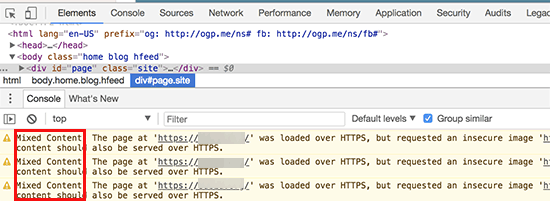
Si noterà che la maggior parte degli URL sono immagini, iframe e gallerie di immagini, mentre alcuni sono script e fogli di stile caricati dai plugin e dai temi di WordPress.
Correggere il contenuto misto nel database di WordPress
La maggior parte degli URL errati sono immagini, file, embed e altri dati memorizzati nel database di WordPress. Per prima cosa correggiamoli.
La cosa migliore sarebbe trovare nel database tutte le menzioni del vecchio URL del sito web che iniziano con HTTP e sostituirle con il nuovo URL del sito web che inizia con HTTPS.
È possibile farlo facilmente installando e attivando il plugin Search & Replace Everything. Per maggiori dettagli, consultate la nostra guida passo-passo su come installare un plugin di WordPress.
Dopo l’attivazione, è necessario visitare la pagina Strumenti ” WP Search & Replace. Nel campo “Cerca”, dovete aggiungere l’URL del vostro sito web con http. Successivamente, aggiungere l’URL del sito web con https nel campo “Sostituisci”.
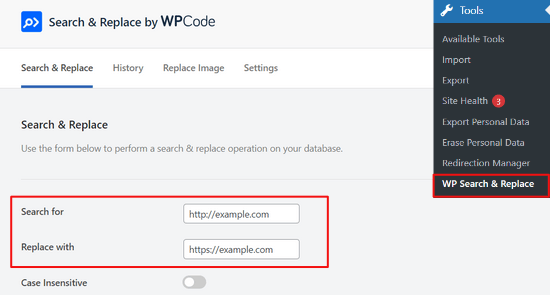
Di seguito, vengono visualizzate tutte le tabelle del database di WordPress.
È necessario selezionarli tutti per eseguire una verifica approfondita.
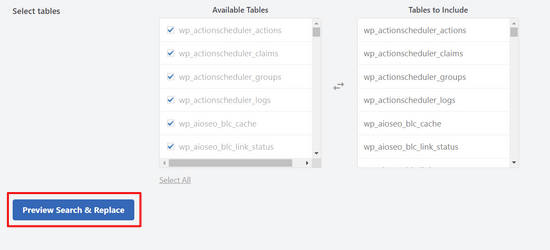
Quindi, fare clic sul pulsante “Anteprima di ricerca e sostituzione” per vedere tutte le modifiche apportate dal plugin.
Infine, fare clic sul pulsante “Sostituisci tutto”.
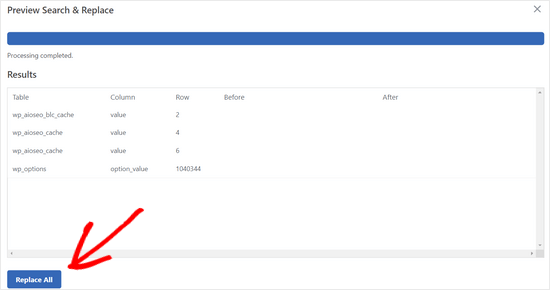
Il plugin cercherà ora nel database di WordPress gli URL che iniziano con http e li sostituirà con URL sicuri https. Potrebbe essere necessario un po’ di tempo, a seconda delle dimensioni del database di WordPress.
Correzione degli errori di contenuto misto nel tema WordPress
Un’altra causa comune degli errori di contenuto misto è il tema di WordPress. Qualsiasi tema WordPress decente che rispetti gli standard di codifica di WordPress non causerà questo problema.
Per prima cosa, è necessario utilizzare lo strumento di ispezione del browser per trovare le risorse e la loro provenienza.
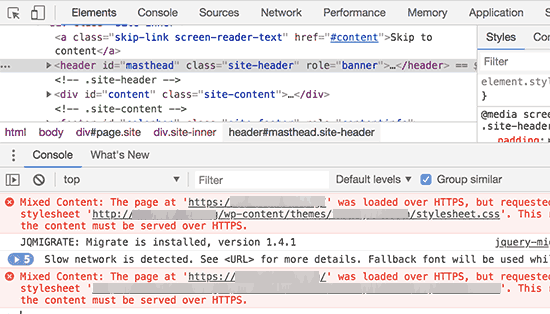
Successivamente, dovrete trovarli nel vostro tema WordPress e sostituirli con https. Questa operazione sarà un po’ difficile per la maggior parte dei principianti, poiché non sarà possibile vedere quali file del tema contengono questi URL.
Correzione degli errori di contenuto misto causati dai plugin
Alcune risorse a contenuto misto vengono caricate dai plugin di WordPress. Qualsiasi plugin di WordPress che rispetti gli standard di codifica di WordPress non causerà errori di contenuto misto.
Non consigliamo di modificare i file dei plugin di WordPress. Dovreste invece contattare l’autore del plugin e farglielo sapere. Se non rispondono o non sono in grado di correggere il problema, è necessario trovare un’alternativa adeguata.
Nota: se per qualche motivo si verifica ancora un errore di contenuto misto, si consiglia di utilizzare temporaneamente il plugin Really Simple SSL, in modo che gli utenti non ne risentano mentre si corregge il problema su un sito web di staging o si assume uno sviluppatore.
Inviate il vostro sito HTTPS a Google Search Console
I motori di ricerca come Google considerano https e http come due siti web diversi. Per evitare problemi di SEO, è necessario comunicare a Google che il sito web è stato spostato.
Per farlo, è sufficiente accedere all’account di Google Search Console e fare clic sul pulsante “Aggiungi proprietà”.

Si aprirà una finestra a comparsa in cui dovrete aggiungere il nuovo indirizzo https del vostro sito web.
Esistono due metodi per la verifica del sito: il nome di dominio o il prefisso URL. Consigliamo il metodo del prefisso URL perché è più flessibile.
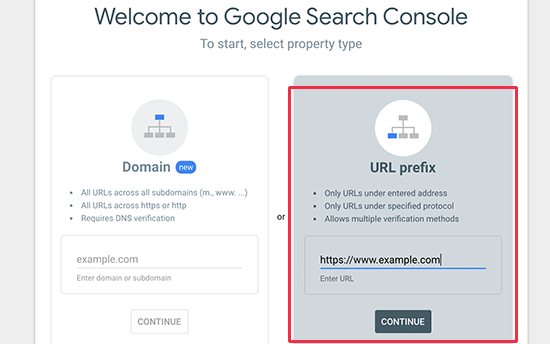
Successivamente, Google vi chiederà di verificare la proprietà del vostro sito web.
Ci sono diversi modi per farlo. Selezionate un metodo qualsiasi e riceverete le istruzioni per verificare il vostro sito. Si consiglia di utilizzare il metodo dei tag HTML.
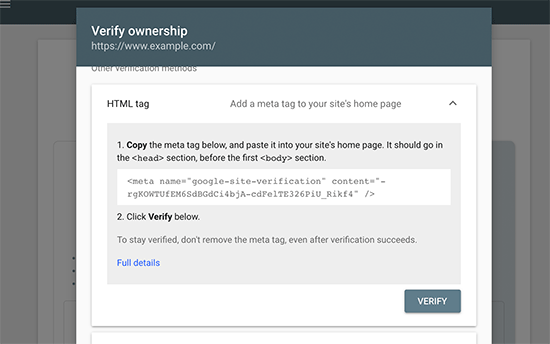
Ora vedrete uno snippet di codice HTML da aggiungere alla sezione head del vostro sito web WordPress.
Aggiungere il codice di verifica di Search Console utilizzando All in One SEO
Innanzitutto, installate e attivate il plugin All in One SEO for WordPress. Per maggiori dettagli, consultate il nostro tutorial su come installare un plugin di WordPress.
Nota: esiste anche una versione gratuita di All in One SEO che potete provare.
Dopo l’attivazione, accedere alla pagina All in One SEO ” Impostazioni generali e fare clic su Google Search Console.
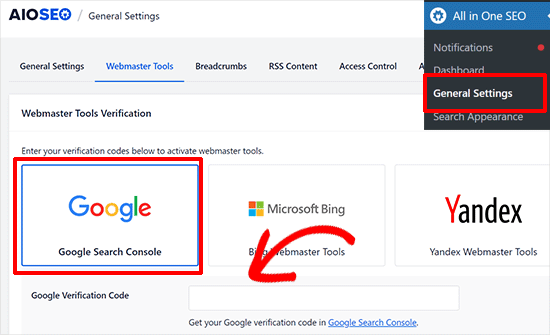
In seguito, è necessario aggiungere il codice di verifica copiato in precedenza dal sito web di Google Search Console.
Non dimenticate di cliccare sul pulsante “Salva modifiche” per memorizzare le impostazioni.
Quindi, tornare alla scheda Google Search Console e fare clic sul pulsante “Verifica”.
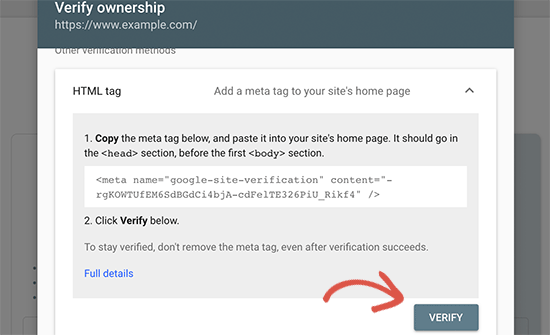
Una volta che il sito è stato verificato, Google mostrerà qui i rapporti della Search Console.
È inoltre necessario assicurarsi che entrambe le versioni https e http siano aggiunte alla Search Console.
Questo indica a Google che volete che la versione https del vostro sito web sia trattata come la versione principale. In combinazione con i reindirizzamenti 301 impostati in precedenza, Google trasferirà le classifiche di ricerca alla versione https del vostro sito web e molto probabilmente vedrete dei miglioramenti nelle vostre classifiche di ricerca.
Risorse bonus
Di seguito sono riportate alcune risorse aggiuntive che possono aiutarvi a risolvere da soli i problemi comuni di WordPress e a saperne di più su WordPress:
- Come correggere i problemi SSL più comuni in WordPress (Guida per principianti)
- Gli errori più comuni di WordPress e come risolverli
- TLS vs SSL: quale protocollo utilizzare per WordPress?
- Come correggere l’errore di connessione sicura in WordPress
Video tutorial
Speriamo che questo articolo vi abbia aiutato ad aggiungere HTTPS e SSL in WordPress. Potreste anche voler consultare la nostra guida definitiva alla sicurezza di WordPress con istruzioni passo-passo per mantenere sicuro il vostro sito WordPress o come rinnovare il vostro certificato SSL.
Se questo articolo vi è piaciuto, iscrivetevi al nostro canale YouTube per le esercitazioni video su WordPress. Potete trovarci anche su Twitter e Facebook.





Yasir
Is this plugin is secured.
WPBeginner Support
Yes, the plugin should currently be secured.
Admin
ammar
Hi, if i’m using the 1st method, do I need to follow the Submit my HTTPS Site to Google Search Console step also after that?
TQ
WPBeginner Support
Yes, you would still want to follow that step
Admin
Swen
I installed the Really Simple SSL plugin, which states that you should manually replace every http:// in all .css and .js files to //. That doesn’t sound really simple to me. As a beginner I set up a simple website with a couple of pictures. Is it common that http:// statements are in these files?
WPBeginner Support
Normally those links are not common so it shouldn’t be something to worry about.
Admin
Lucas
Hi,
When adding the code to .htaccess, i get a “too many redirects” error. I tryed adding to the existing code above, below, and also erasing the existing code and using only the new. All three option get too many redirects.
Is there something I should change there? Thanks in advance for your help!
WPBeginner Support
You would want to try some of the suggestions in our article here:
https://www.wpbeginner.com/wp-tutorials/how-to-fix-error-too-many-redirects-issue-in-wordpress/
for resolving the too many redirects and should those recommendations not work, you would want to check with your hosting provider to ensure they do not have a system that needs to be modified to point to the https version of your site.
Admin
Sotir Sotirov
I’ve tried using the plugin but when I do the website becomes not accessible. I’ve tried the manual approach but once I’ve changed the addresses in WP settings the site becomes not accessible again.
WPBeginner Support
You would want to reach out to your hosting provider to ensure that your SSL certificate is connected to your domain correctly and they should be able to help
Admin
Mike Ashworth
I am about to make the change to SSL and will be following the guidance in te article, initially using the really simple ssl plugin. Before i begin i have a quick question.
If I use the really simple ssl plugin, which takes care of everything, i can leave the general settings in wordpress for wordpress address and site address as http rather than change to https as the plugin will be taking care of it?
WPBeginner Support
Correct
Admin
Mike Ashworth
Thanks for confirming. I have one other rquestion.
having just activated lets encrypt ssl on siteground for a website, i am asked wther i want to switch the following on or leave it off.
HTTPS Enforce – Forces your site to work entirely over an encrypted HTTPS connection. The redirect is performed on server level and works for any website.
Do i leave this off as the really simple ssl plugin will take care of this as well?
WPBeginner Support
Yes, you can leave that off, you would only want to use that should there be any issues with the plugin or Google finding http links
Mike Ashworth
Thanks for your advice. WP Beginner is such an awesome website. Keep up the great work!
stephan
I want to thank you a lot. I have been looking for the errors over 12hours and get it done with better replace plugins. Thanks a lot dear.
WPBeginner Support
Glad our recommendation could help you
Admin
Arlina
Does adding in the plugin of SSL slow down my blog speed performance?
WPBeginner Support
It shouldn’t slow your site down
Admin
Peter Wilson
Can someone tell me, do I replace the contents on my.htaccess. file with the suggested code or do I place it and the beginning/end of the eisting entry.
WPBeginner Support
You would add it at the end of the current code in your htaccess file.
Admin
Peter Wilson
Thanks for the quick reply. So, would that be after the existing and before the # END WordPress, or does it go after the .
WPBeginner Support
That should not matter, it may be a good idea to do it after should you need to remove the code in the future
Shivanandana
Really awesome guide. Thank you so much! Thanks again for this detailed post!
WPBeginner Support
Glad you like our content
Admin
Håkan
Great content, helped me alot!
WPBeginner Support
Thank you, glad our content was helpful
Admin
Harsha
Very useful guide, thank you very much!
WPBeginner Support
You’re welcome, glad our article was helpful
Admin
Jan-Peter Molenaar
Thanks a lot!! Valuable content
WPBeginner Support
You’re welcome, glad our content is helpful
Admin
Greg
This article was so helpful. Thank you so much! Made it very easy.
WPBeginner Support
You’re welcome, glad our article was helpful
Admin
Nel
Most helpful guide ever. Thank you for this.
WPBeginner Support
You’re welcome
Admin
Jessica Quadra
This was so helpful and each step worked perfectly. Thank you!!
WPBeginner Support
You’re welcome, glad our guide could help
Admin
Hassen Loukil
Hi!
Thanks for the article!
What about google analytics? Same thing as Google search console or not?
WPBeginner Support
For Google Analytics you should be able to update to https under your property settings
Admin
Arif Ahmed
When I enable “WordPress 301 redirection to SSL” option from “Really Simple SSL Plugin” it works fine, but it removes query parameters. For example, when I get users from Adwords campaign it strips off gclid parameters.
Please guide
WPBeginner Support
You would want to reach out to Really Simple SSL’s support to see if there is an option for query strings.
Admin
Oswald Porter
Thanks for your helpful article.
The manual SSL/HTTPS set up seems be be working for the main site.
However the mixed content error (images) still appears after using the Better Search Replace plug-in.
At Media Library, images appear with ‘https’, but not at the site’s each post
Indeed, at all posts, when I right-click on the post image > ‘Copy image address’, it shows:
http://
Ideas? Thanks in advance.
WPBeginner Support
You would want to start by clearing any caching on your site and if that doesn’t work you could try the velvet blues plugin from our article: https://www.wpbeginner.com/plugins/how-to-update-urls-when-moving-your-wordpress-site/
Admin
Kathy
Hi,
I used this tutorial on many sites and it works like a charm. Thanks for that.
Do you know if I can also use it to update my multisite(s). Or are additional steps needed?
WPBeginner Support
Depending on how your multisite is set up there are normally more steps involved. If you reach out to your hosting provider they can normally help
Admin
Ralph
Thanks, very nice tutorial.
WPBeginner Support
Thanks, glad you liked our guide
Admin
Oz
Fantastic and straightforward!
What steps do we need to take to make sure our social share count (e.g., Facebook, Twitter) are still available?
WPBeginner Support
You could try 301 redirecting the http articles to https but unless I hear otherwise, social media sites see the two as different links so you are likely going to lose your shares unless they have added a method to update your share counts.
Admin
Ahsan
I used cloudflare for free SSL but my traffic has dropped 25%. Is this due to cloudflare?
WPBeginner Support
There are multiple possible reasons for a change in traffic so it is hard to say if that is the only reason or if there were other reasons for a drop in traffic.
Admin
Shawn
Thank you for such a great piece of content.
It seems like using the Really Simple SSL plugin is way easier than changing codes and scripts on my own.
My question – what if the plugin did not get updated in the future? Is this going to cause a problem for our urls?
And, after installing the SSL from my web host, all I need to do is to activate Really Simple SSL plugin and everything will be redirected to https?
Shawn
WPBeginner Support
It would depend on what changes in WordPress’ core code and how long it has not been updated for the possible issues. The plugin should automatically update your content that it is able to use HTTPS without you needing to modify anything on your end if you wanted.
Admin
Nathaniel
Just wanted to say thank you. I was not looking forward to doing this, but you’re guide made it easy and quick. Thanks!!!
WPBeginner Support
Glad our guide could help
Admin
Sheri Ellis
I made the mistake of following your manual instructions before our SSL cert had been installed. All I did was edit the general settings for the URL to https. And now the site is hosed. I’ve been editing every PHP file to include:
define( ‘WP_HOME’, ‘http://mysite.com’ );
define( ‘WP_SITEURL’, ‘http://mysite.com’ );
and it’s being ignored. So now my site is hosed. FYI I’m using WordPress 5.1.1 which appears to have significant changes. Help!
WPBeginner Support
You should be able to edit the url back using phpMyAdmin similar to our article here: https://www.wpbeginner.com/beginners-guide/how-to-reset-a-wordpress-password-from-phpmyadmin/
and edit the options table rather than the users table.
Admin
Sheri Ellis
Thanks for the response but it didn’t work. I ran mysql command line to update the wp_options table and set option_value to http where option_name in (‘home’,’siteurl’). I have also inserted the define HOME and SITEURL commands into many PHP files including wp-config.php, and also added define( ‘RELOCATE’, true );
Still hosed. Appreciate any additional suggestions!
WPBeginner Support
You may want to ensure if you have a caching plugin that you disable it, as you are unable to log into the site you could use: https://www.wpbeginner.com/plugins/how-to-deactivate-all-plugins-when-not-able-to-access-wp-admin/
otherwise, if you reach out to your hosting provider they should be able to assist
Sheri Ellis
Had tried that as well, with no luck. I had to blow away the entire site and reinstall WP. But appreciate the effort!
John J Cooke
This made making the switch a snap. I was sitting on the ssl cert with no sure way how to convert. Really appreciate the easy instructions.
WPBeginner Support
Glad we could make the process easier for you
Admin
Mandee
Oh my goodness, THANK YOU! I’ve reached out to my hosting company, as well as a developer. They both made it seem like an impossible task to do on my own. Just took care of this is literally 30 seconds because of you. I can’t thank you enough! I wish I would have found this article sooner—would have saved me a lot of headache!!
WPBeginner Support
Glad our article could help
Admin
Jerry
Hi,
I tried twice your step guide end everything worked great. Now that i have SSL i am trying to migrate but there is a problem on the final step, so it cannot be finalized. Is it a problem i had Lets Encrypt on old server and now that the new one has another, to have caused a problem. Would you recommend remove SSL on old hosting and after that using dublicator to start the articles process?
WPBeginner Support
Who has your SSL should not be a factor for it not working, you could try to see if that works but it is normally due to another cause.
Admin
BILAL ALI AHMAD
Hi,
I applied all steps and https version is working fine on my website but the non-https version is still accessible when I type http: mysite.com
how to resolve this issue?
Also when I click on my google search link for my website user also lands on non-https version and after that if I access the website again it comes with https
please tell me how to resolve this issue?
WPBeginner Support
If you already submitted your site to Google’s Search console then Google may have cached the http version in their search. For the http version being available, you may want to ensure the redirects were all saved.
Admin
Clement
This was surprisingly simple that’s why I rely on you guys, had actually thought it would be horrible.
WPBeginner Support
Glad our guide could make it easy for you
Admin
Marc-Lyon
Thanks for the great tutorial. Only issue I’m stuck with is that URLs with www appended give an error message in browser:
“This site can’t provide a secure connection uses an unsupported protocol.
ERR_SSL_VERSION_OR_CIPHER_MISMATCH
Unsupported protocol
The client and server don’t support a common SSL protocol version or cipher suite.”
I’ve checked and both non-www and www versions have valid SSL certificates. Any idea why the www version is not working?
WPBeginner Support
Start by reaching out to your hosting provider to ensure they don’t have a setting on their end for the www specific version of your site.
Admin
Marc-Lyon
Managed to sort it out. Cloudflare was causing the issue.
Solution: disable and re-enable Universal SSL under Crypto settings.
WPBeginner Support
Glad you were able to find the cause and thanks for sharing the solution should anyone else run into the issue
Rock
Very helpful blog. Thanks.
WPBeginner Support
You’re welcome
Admin
illy
All my images were inserted with http protocol. I used Better Search Replace to fix this and it worked like a charm!
thank you
WPBeginner Support
Glad our recommendation could help
Admin
Didier
I have a problem with the redirect from http to https.
Using the above mentioned code in the .htaccess file,
my index page http:// example.com redirects to httpS:// example.com
BUT
A subpage http:// example.com/sublink does NOT redirect to https:// example.com/sublink
Does anybody know how to solve this?
Thank you!
WPBeginner Support
You may want to reach out to your hosting provider to ensure they are not overriding any redirects on your site or if they see the code was copied incorrectly.
Admin
Jason
Yeeeeeeeeeeeeeeeeeeeeeeeeeeeeeeeees! The first WP edit that has ever worked first time for me! I’m taking the rest of day off to celebrate.
WPBeginner Support
Glad our guide could help
Admin
Leo Al
Thanks a lot!
It worked
WPBeginner Support
Glad our article could help
Admin
Igor N
Thanks, that was really helpful. I went with the method 2 and everything was just fine.
WPBeginner Support
Glad our tutorial could help and you got it working
Admin
Pamela
This detailed article saved a beginner like me! So helpful. Thank you very much.
WPBeginner Support
Glad our guide could be helpful
Admin
Rafaqat Ali
Hi thanks for the article, I have shifted my site to ssl by using the article elaborated above.
Let me clear a few things:
1- I have added a new property in Google search console with https:// should I delete the http:// property or remain the both.
2- How long it will take to show google search data in the search console report.
3- Should I make a 301 redirect to https:// version.
4- How to get all my backlinks to https:// version.
( i have submitted the XML sitemap and robots..txt file also with new property)
Thanks for your time
WPBeginner Support
Hey Rafaqat,
If you have set up 301 redirect to your HTTPS urls, then you can leave them both. They would start appearing in search very soon, however of your redirects are properly setup you wont see any difference in your traffic or search rankings.
Admin
Belinda
Thankyou so so much, this article helped me fix both my blog and online store.
Roberto
It is an amazing article, I solve my problem and now I have my site up and running. Thanks so much!
Editorial Staff
You’re very welcome Roberto
Admin
Eva
Hi and thank you for the detailed tutorial
I have activated the ssl protocol on a new wordpress installation and after the activation the site’s started opening with https and green padlock ( all pages, with and without www search and if searching http version) even the admin area as far as the theme and editor , however the wordpress and site URL fields in the settings General page still need to be changed to https as they appear as http and any new publication (so as the ones alredy been there) has http link and when editong page appearancefrom main menu it shows exclamation mark oven the secure connection padlock
In that case do I need to go thru all process or after updating the general settings page to https it will be ok ?
It’s my first time doing that and I prefer ( if have to) to do it manually by the 2 method as it very well explained
Thanks
WPBeginner Support
Hi Eva,
You can try the second method or follow the instructions in the first method. You will need to change the URLs in settings as it tells WordPress to use https in URLs.
Admin
Bernard Brillo
I’ve tried following the manual tutorial but I end up seeing a blank white page on my homepage and all of my other page are now inaccessible. My website is hosted in Amazon and I’m also using W3 total cache.
Do I need to do something else to make this work?
Any suggestions will be much appreciated.
Donatas Vaiciulis
On my website was W3 total cache, when I disabled it worked everything fine. I think after htaccess edit needed to reinstall plugin and do w3 settings again. Not tried yet, soon will try.
Josh
I did method 1 and it worked perfectly. Thanks so much for the tutorial!
Karo Itoje
Hello,
As usual thanks for the detailed tutorial. I decided to do the manual option (option 2) because it seemed simple enough to follow through. However when I pasted the second code for nginx servers into configuration file (wp-config.php) I got a syntax error. So I had to remove the code. But I will still like to follow through with that option so if you can please maybe take a look at that code again and correct it then I’ll really appreciate it.
Also just to get this clearly, it is either:
“set up WordPress redirects from HTTP to HTTPS by adding the following code to your .htaccess file.”
OR THIS
“If you are on nginx servers (most users are not), then you would need to add the following code to redirect from HTTP to HTTPS in your configuration file:”
Not both right?
mostafa elaissaoui
thank u
realy you help me thank you
Rohan Kothari
Hi,
I am planning to start an e-commerce store. Do I need to purchase a wildcard SSL certificate and a dedicated IP to enable payments on my website or will the free SSL certificate bundled with web hosting plans be adequate?
Oliver
Hi Guys,
1st off a great and helpful article, thanks. I have changed my site from http to https and it took a lot less time than I expected, using the Better Search and Replace manual method. But now I can’t seem to change the address of the http version in the Google Search Console. It has both of the sites there but won’t allow me to swap. Is this necessary to do? It seems as if the redirects are working. Should I get the https site indexed as much as possible or will google do that with the http redirects anyway?
WPBeginner Support
Hi Oliver,
If you have both sites in the search console and a redirect in place, then Google will automatically detect the transition and will start showing reports for your HTTPS site.
Admin
Victor Fernando
I used the first method, although I have experience in programming, I don’t have it in wordpress and I don’t dare to get my hands on the code even though it’s not that complicated.
the first method worked i.e. installing the free plugin version.
Thanks for the tip